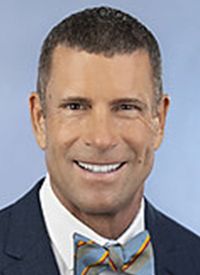News
Article
Engineered Bone Marrow Shows Preclinical Potential in Osteosarcoma
Author(s):
R. Lor Randall, MD, FACS, emphasizes the overall potential for investigating the utility of engineered bone marrow in patients with osteosarcoma.
R. Lor Randall, MD, FACS

Implanting demineralized bone matrix subfascially vs subcutaneously improved robustness and bone marrow space, thereby suggesting that engineered bone marrow has the potential to benefit patients with osteosarcoma, according to data from a preclinical study published in The Proceedings of the National Academy of Sciences.1
“We're excited about this work, and I think it will be a paradigm setting for a new way by which to look at the microenvironment in bone for sarcomas arising from the bone and then metastasis to the bone,” R. Lor Randall, MD, FACS, explained in an interview with OncLive®.
In the interview, Randall emphasized the overall potential for investigating the utility of engineered bone marrow in patients with osteosarcoma, which highlights the ongoing research that is being conducted at the University of California (UC) Davis Comprehensive Cancer Center in Sacramento, California. Randall is the David Linn Endowed Chair for Orthopedic Surgery, the chair of the Department of Orthopedic Surgery, and a professor at UC Davis Comprehensive Cancer Center.
OncLive: Could you provide an overview of what preclinical modeling is, and what the current armamentarium looks like?
Randall: Preclinical modeling in cancer research is a real challenge. By definition, a model is not the real thing. It's something that is supposed to mimic a clinical scenario and variables can be manipulated to use scientific methods to hopefully get improved care by discovering treatments and therapeutic targets. In sarcoma research, we have generally used a variety of in vitro and in vivo models.
Some of those have been included in the in vivo world murine mouse models genetically engineered or immunocompromised, and both have advantages and disadvantages. We haven't been able to tease out optimal ways by which to manipulate variables in a very stringent way to look at improving therapies and outcomes.
What work has been done with preclinical modeling in patients with osteosarcomas at UC Davis Comprehensive Cancer Center?
Here at UC Davis, with our strong engineering background, we approached several of our biomedical engineers about some research opportunities. They came up with this engineered bone marrow idea, which we recently published in The Proceedings of the National Academy of Sciences, which is a very rigorous journal. This came out [in September 2023]. What we were able to do in this is build a bone marrow mimicker that allows us to recreate the native environment from which an osteosarcoma might arise.
It allows us to build the tumor microenvironment in a very stringent way and we incubated in a mouse, and can manipulate things such as oxygen tension, polarity of macrophages, and a variety of other factors to look at how this affects the initial steps of osteosarcoma genesis.
We can also then introduce therapies into this model to see how it affects the tumor genesis, as well. We use some doxorubicin, which is a standard therapy for osteosarcoma treatment, to see how it affected tumor cells.
What results were found from your investigation?
It did mimic the effects that we see in the clinical scenario. It has been exciting. The other nice thing about this model is it doesn't have to only be utilized for bone sarcomas and creates the microenvironment from which a bone sarcoma might arise. However, we can also use it for secondary carcinomas that migrate to or metastasize to the bone marrow; metastatic bone disease in other words, where breast, prostate, lung, thyroid, and renal cell cancers all have a predilection for metastasizing to the bone marrow or in the bone.
We can use this model to understand how those metastases set up shop in the bone and proliferate and progress to cause bony destruction.
What have been some of the challenges in osteosarcoma to develop meaningful and effective treatments for patients, particularly those with metastatic disease?
We have plateaued in osteosarcoma. Since the 1980s, we really haven't moved the needle in terms of improving outcomes. We've plateaued in anywhere from 65% to 75% cure rates for locally advanced osteosarcoma, and it's far less for metastatic osteosarcoma. We use conventional cytotoxic chemotherapy methotrexate cisplatin and doxorubicin.
We usually call this MAP for methotrexate, doxorubicin, and then cisplatin. MAP therapy has been the only tried and true treatment for osteosarcoma. There have been a lot of other drugs that have come to clinical trials that have not really been shown to improve outcomes.
The Children's Oncology Group and many other cooperative groups around the world have not been able to discover new agents. Clinical trials will continue to come forward with promising and hopefully, effective treatments. In the meantime, what we want to do with this engineered bone marrow is to be able to very carefully look at factors that enable a nonmetastatic clone of cells to become metastatic in the bone marrow.
How could this model potentially be used to fuel future research for these patients?
This paper is really a proof of principle paper around the model. Then the exciting stuff comes to follow, which is, what we can learn about those initial steps that select for the tumors. What about the clones of tumor cells that will break away from the main tumor to metastasize elsewhere?
Overall, I want to recognize our collaborators across UC Davis, the biomedical engineering group, the veterinary medicine group, and orthopedics. It's really been a collaborative effort and we're excited to share this work with the sarcoma community.
Reference
Griffin KH, Thorpe SW, Sebastian A, et al. Engineered bone marrow as a clinically relevant ex vivo model for primary bone cancer research and drug screening. PNAS. 2023;120(39):e2302101120. doi.org/10.1073/pnas.2302101120









